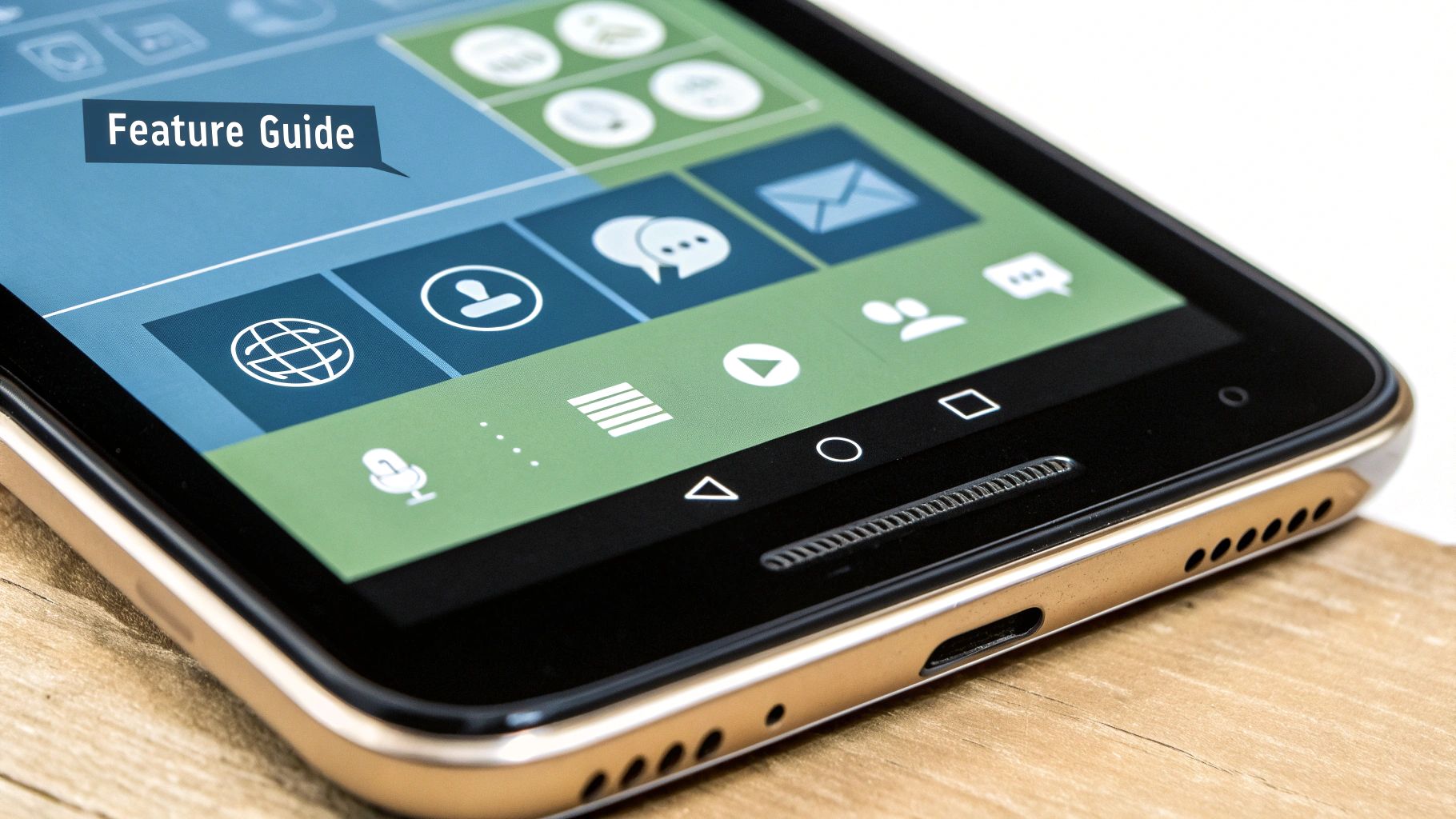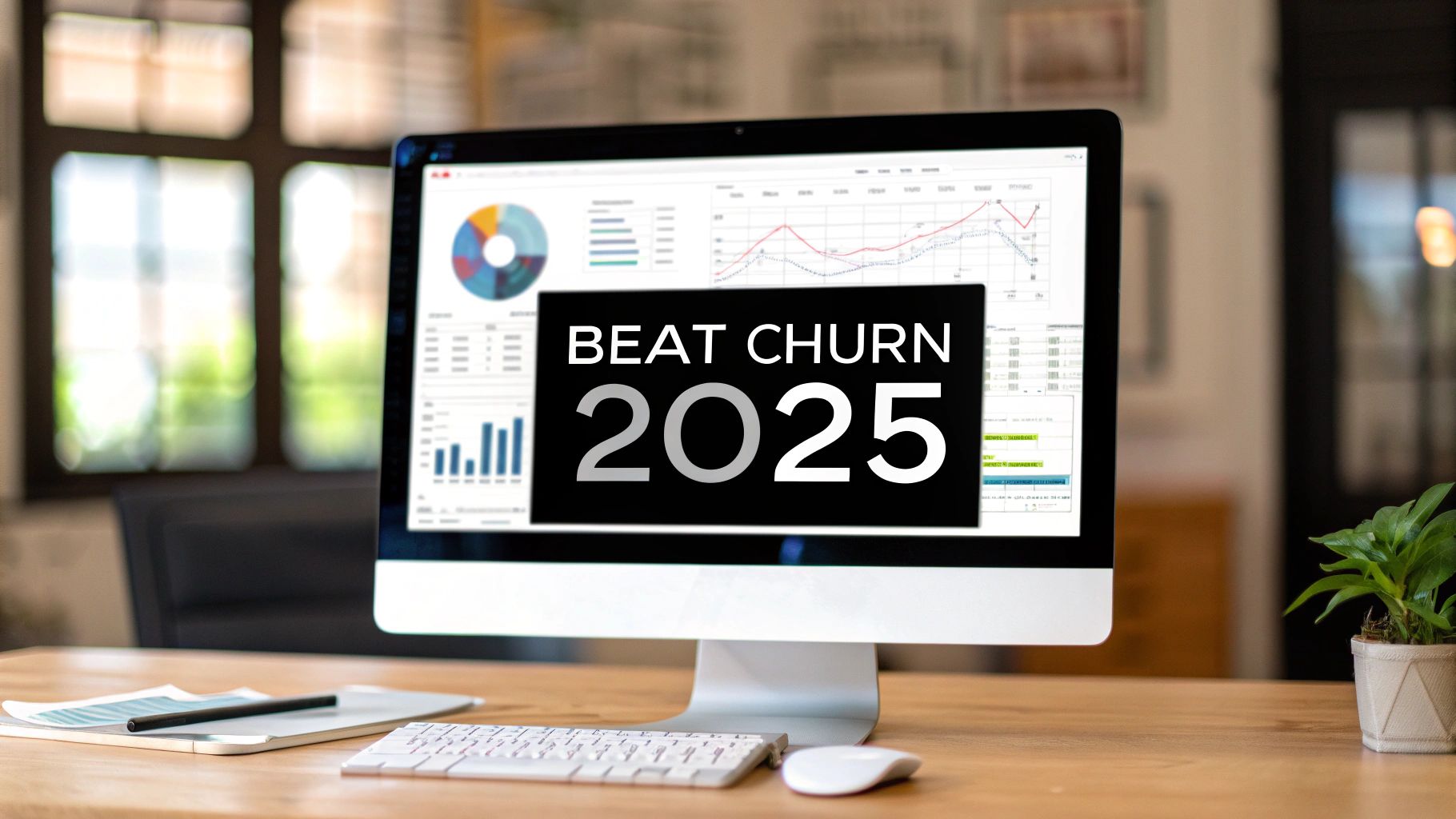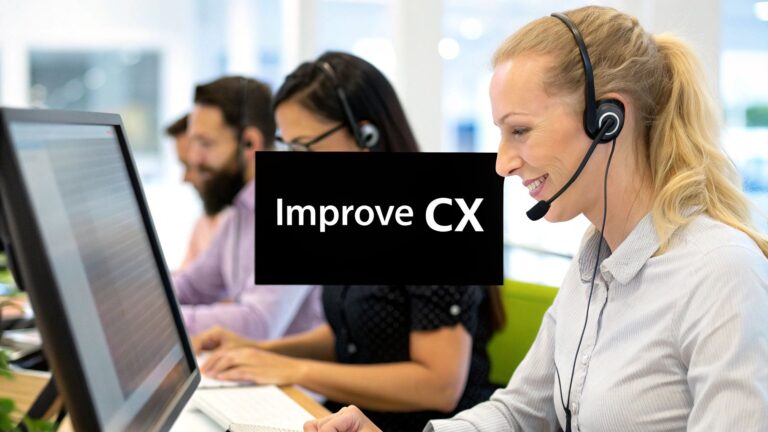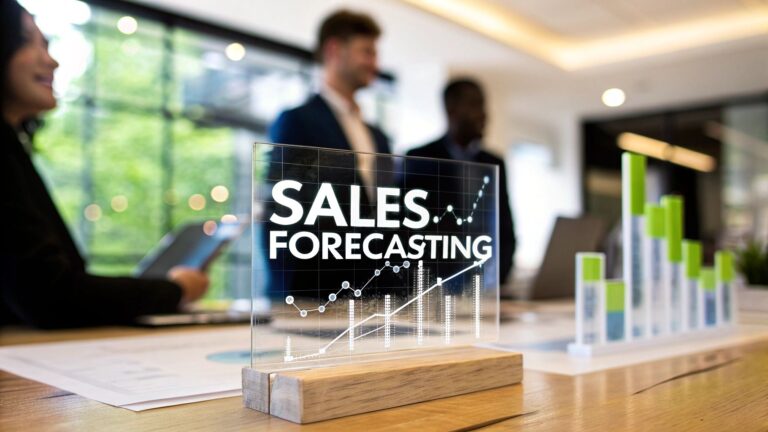7 SaaS Customer Retention Strategies to Beat Churn in 2025
In the hyper-competitive SaaS market, acquiring a new customer is a celebrated win. Yet, the real measure of long-term success isn't just about acquisition; it's about retention. The relentless pursuit of new leads often overshadows a more profitable activity: keeping the customers you already have. High churn is a silent business killer, quietly eroding your monthly recurring revenue (MRR) and inflating your customer acquisition costs (CAC). Focusing on retention isn't just a defensive move; it's your most powerful growth lever.
This guide provides a comprehensive blueprint of seven proven SaaS customer retention strategies that deliver tangible results. We're moving past the obvious "listen to your customers" advice to give you a detailed, actionable playbook. You will learn how to transform a user's initial onboarding into a long-term commitment, build proactive customer success programs that preempt problems, and use feedback loops to build a product that customers can't live without. Each strategy is broken down into practical steps you can implement immediately.
We will explore tactics that cover the entire customer lifecycle, from optimizing the first crucial moments a user spends in your app to leveraging data for predicting and preventing churn. Whether you're a founder, a marketing leader, or a product manager, these insights will equip you to build a loyal customer base that not only stays but also becomes your most effective sales channel. Let's dive into the strategies that turn customers into advocates and drive sustainable, scalable growth.
1. Onboarding Optimization
The first 90 days of a customer's journey are often the most critical, and a flawed initial experience is a primary driver of churn. Onboarding optimization is a systematic approach to guiding new users from their initial sign-up to their first moment of value, often called the "Aha!" moment. This process is one of the most powerful saas customer retention strategies because it directly tackles early-stage churn by proving the product's value quickly and efficiently.
A strong onboarding process transforms a curious new user into an engaged, confident one. It sets the foundation for long-term loyalty by demonstrating that your SaaS platform can solve their problem, thereby making it an indispensable part of their workflow. When customers achieve a meaningful outcome shortly after signing up, they are significantly more likely to integrate the product into their daily operations and continue their subscription.

How to Implement Onboarding Optimization
Effective onboarding isn't just a product tour; it's a guided journey to success. Instead of showing users every feature, focus on the core actions that deliver initial value.
- Identify the "Aha!" Moment: First, pinpoint the key action or outcome that makes users understand your product's core value. For a project management tool, this might be creating their first task and assigning it to a team member. For an analytics platform, it could be seeing the first meaningful data insight on their dashboard.
- Create a Guided Path: Design an in-app, step-by-step workflow that leads every new user directly to that "Aha!" moment. Use tooltips, checklists, and progress bars to keep them engaged and motivated. For a deeper dive into structuring this journey, you can explore some established client onboarding best practices.
- Personalize the Experience: Segment users based on their role, goals, or industry. A marketer using a CRM needs a different onboarding path than a sales manager. Personalization makes the process more relevant and accelerates the time-to-value.
Real-World Examples
- Slack: Slack’s onboarding process excels by focusing on a single, crucial goal: getting a new team to send its first few messages. It prompts the user to create a channel and invite teammates immediately, knowing that the product's value is only realized through collaboration.
- Canva: Canva guides new users to create their first design within minutes. It provides simple templates and an interactive tutorial, ensuring users experience a quick win and see the power of the tool firsthand.
2. Customer Success Programs
Beyond a reactive support model, a proactive customer success program is one of the most essential saas customer retention strategies for long-term growth. This approach shifts the focus from simply solving problems as they arise to ensuring customers consistently achieve their desired outcomes with your product. It’s a partnership dedicated to maximizing the value they receive, thereby making your SaaS indispensable.
Customer success is not just customer support with a different name; it's a strategic, data-driven function. By monitoring usage, providing guidance, and building relationships, customer success managers (CSMs) can preemptively address potential issues, identify expansion opportunities, and transform satisfied customers into vocal advocates. This proactive engagement directly correlates with higher retention, as customers who see tangible results have no reason to look elsewhere.

How to Implement Customer Success Programs
Building an effective customer success program involves creating a structured, proactive system for managing customer relationships and outcomes. The goal is to move from a reactive to a strategic posture.
- Segment and Assign Touch Levels: Not all customers require the same level of attention. Segment your customer base by value (e.g., Annual Recurring Revenue) or growth potential, and assign appropriate touch levels. High-touch for enterprise accounts might involve dedicated CSMs and quarterly business reviews, while a tech-touch model for smaller accounts could use automated email sequences and webinars.
- Develop Customer Health Scores: Create a health score to objectively measure customer engagement and satisfaction. This score can combine metrics like product usage frequency, feature adoption, support ticket volume, and survey responses. A declining score is an early warning sign that allows your team to intervene before a customer churns.
- Create Standardized Playbooks: Don't leave interactions to chance. Develop playbooks for common scenarios like onboarding, risk mitigation (e.g., a drop in usage), and renewal conversations. These standardized processes ensure consistent and effective engagement across your entire customer success team.
Real-World Examples
- Salesforce: A pioneer in this field, Salesforce provides enterprise accounts with dedicated CSMs who act as strategic advisors. It also fosters a massive user network, the Trailblazer Community, to facilitate peer-to-peer support and learning, ensuring users at all levels can achieve their goals.
- Gainsight: As a leading customer success platform, Gainsight practices what it preaches. It uses its own software to monitor customer health, automate workflows, and provide its CSMs with the data needed to proactively guide customers toward their business objectives, turning its product into a case study for success.
- ChurnZero: ChurnZero excels by providing tools for automated customer success. Its platform allows SaaS companies to create automated, personalized journeys and interventions based on user behavior, enabling even small teams to manage a large customer base proactively and efficiently.
3. In-App Engagement and Feature Adoption
Once a customer is onboarded, the journey to retention is far from over. In-app engagement and feature adoption strategies focus on guiding users beyond the basics to discover and master the full spectrum of your product's capabilities. This is one of the most proactive saas customer retention strategies because it continually demonstrates new sources of value, transforming casual users into power users who can't imagine their workflow without your tool.
A customer who only uses 10% of your product's features is at a high risk of churning, as they may not perceive enough value to justify the cost. By strategically promoting feature discovery, you can increase the "stickiness" of your platform. When users integrate multiple advanced features into their daily routines, your product becomes more deeply embedded and difficult to replace, securing long-term loyalty and reducing churn.

How to Implement In-App Engagement and Feature Adoption
The goal is to provide the right guidance at the right time, making feature discovery feel natural rather than intrusive. Instead of generic pop-ups, use contextual, behavior-driven prompts to highlight relevant functionality.
- Use Behavioral Triggers: Trigger tooltips or guides based on what a user is doing in the app, not on a timer. For example, if a user exports the same report manually three times, prompt them with a guide on how to automate it.
- Personalize Recommendations: Tailor feature suggestions based on user roles and past behavior. A project manager might see a prompt about advanced Gantt chart features, while a designer on the same team is guided toward new collaboration tools. This approach aligns with modern sales enablement best practices by equipping users with the precise tools they need to succeed.
- Create Feature Adoption Funnels: Track how users move from awareness of a feature to regular use. This allows you to identify drop-off points and optimize your in-app messaging to improve adoption rates for features that correlate highly with retention.
- Allow User Control: Always give users the option to dismiss or postpone guidance. Forcing tutorials on experienced users can create frustration and harm the user experience.
Real-World Examples
- Notion: Notion's template gallery is a masterclass in feature adoption. Instead of just describing its database features, it provides ready-to-use templates for project management, content calendars, and more, encouraging users to explore advanced functionality in a practical, hands-on way.
- Figma: Figma uses subtle in-app messaging to promote its powerful collaborative features. When multiple users are in the same file, it might highlight features like "Observation Mode" or new commenting tools, encouraging deeper teamwork directly within the user's workflow.
- Airtable: As users build more complex bases, Airtable provides view-specific tips and contextual suggestions for advanced features like scripting and automations. This graduated approach helps users master the platform's depth without feeling overwhelmed.
4. Pricing and Packaging Optimization
Your pricing is more than just a number; it's a core part of your product experience and a powerful lever for retention. Pricing and packaging optimization is the strategic process of structuring your subscription tiers to align perfectly with the value customers receive. This is one of the most impactful saas customer retention strategies because it prevents churn caused by a mismatch between price, features, and a customer's actual needs.
When customers feel they are on the right plan, paying a fair price for the value they get, they are far less likely to seek alternatives. A well-designed pricing model accommodates a customer's growth, making it easy and logical for them to scale with you rather than switch to a competitor. This strategy turns your pricing from a potential point of friction into a pathway for long-term partnership.

How to Implement Pricing and Packaging Optimization
Effective pricing isn't about being the cheapest; it’s about aligning your monetization with your customer's success metric. This ensures that as they grow and find more value, their plan grows with them seamlessly.
- Align Pricing with a Value Metric: Tie your pricing tiers to a core metric that represents the value customers get from your product. This could be per user, per contact, per project, or based on feature usage. This ensures customers feel the price is fair as their usage expands.
- Make Upgrade Paths Clear and Beneficial: Design your packages so the next tier up is an obvious and attractive choice for a growing customer. Clearly communicate the added value of upgrading, focusing on benefits like increased efficiency, new capabilities, or higher limits that solve their next set of problems.
- Offer Usage Analytics and Alerts: Be proactive and transparent. Provide customers with a clear dashboard showing their usage against their plan limits. Send automated alerts when they are approaching their limits to prevent surprise overage charges and frame the upgrade conversation positively.
- Regularly Review and Solicit Feedback: Pricing shouldn't be set in stone. Periodically survey your customers, especially those who have recently upgraded or churned, to understand their perception of your pricing. Use this feedback to refine your packages and ensure they remain relevant.
Real-World Examples
- Zoom: Zoom’s pricing model allows for seamless scaling. A small team can start with a free or basic plan and easily upgrade to Pro, Business, or Enterprise tiers as their meeting needs and team size grow, without any friction or need to migrate platforms.
- Atlassian: Atlassian (for products like Jira and Confluence) primarily uses a per-user pricing model. This directly aligns their revenue with their customer's team growth, making it a natural and predictable expense that scales alongside the customer's own success.
- Mailchimp: Mailchimp brilliantly ties its pricing to the number of contacts in a user's list. As a customer's audience grows (a key success metric for their business), their plan scales with them, unlocking more advanced features along the way that support their expanding marketing efforts.
5. Customer Feedback Loops and Product Development
Listening to your customers is one thing; actively building your product based on their input is a game-changer. Establishing a customer feedback loop is a systematic process for collecting, analyzing, and acting on user feedback to drive product improvements. This is one of the most powerful saas customer retention strategies because it makes customers feel like co-creators, deeply invested in the platform's evolution.
When customers see their suggestions and pain points directly addressed in new features or updates, it builds immense trust and loyalty. It proves that you are not just selling a static tool but are a responsive partner committed to their success. This transforms the customer relationship from a simple transaction into a collaborative partnership, making them far less likely to churn.
How to Implement Customer Feedback Loops
A successful feedback loop is more than a suggestion box; it's a transparent process that integrates customer insights directly into your development cycle. The goal is to show customers they are heard and their input has a tangible impact.
- Systematize Collection: Use multiple channels to gather insights. Implement in-app surveys (like NPS or CSAT), create dedicated feedback portals, and encourage customer support teams to tag and categorize feature requests. The key is to have a centralized system to aggregate all this data.
- Prioritize and Analyze: Not all feedback is equal. Develop a scoring system to prioritize requests based on factors like the number of users requesting it, its alignment with your product vision, and the potential revenue impact. Use both quantitative data (surveys) and qualitative insights (customer interviews) to understand the "why" behind the requests.
- Close the Loop: This is the most critical step. When you release a feature based on customer feedback, proactively notify the users who requested it. A simple email saying, "You asked, we built it!" reinforces their value and demonstrates that their voice matters. This communication is essential for making the loop effective.
Real-World Examples
- Superhuman: The email client famously built its product on an engine of intense, one-on-one customer feedback. Founder Rahul Vohra's team conducted extensive interviews and onboarding calls, meticulously tracking every piece of feedback to fine-tune the user experience and build a product users couldn't live without.
- Canny: Tools like Canny allow companies such as Buffer and ClickUp to create public roadmaps where users can submit feature requests, upvote others' ideas, and see what's being built next. This creates a transparent and collaborative development process that fosters a strong sense of community and investment.
6. Proactive Communication and Education
Waiting for customers to encounter a problem before you engage with them is a reactive stance that leads to churn. Proactive communication and education flips this model, transforming your company from a simple software vendor into an indispensable partner in your customers' success. This approach is one of the most effective saas customer retention strategies because it builds trust, demonstrates value beyond the product itself, and empowers users to achieve better outcomes.
A strong educational strategy ensures customers are continuously discovering new ways to leverage your platform, maximizing their return on investment. By providing timely updates, valuable insights, and accessible learning resources, you keep your brand top-of-mind and embed your solution deeper into their operations. When customers see you as a source of expertise in their field, their loyalty transcends features and pricing, creating a powerful competitive moat.
How to Implement Proactive Communication and Education
A successful strategy involves delivering the right information to the right user at the right time, through the right channel. The goal is to educate and empower, not just to inform.
- Segment Your Communications: Don't send the same message to everyone. Segment your audience based on their lifecycle stage, usage patterns, or subscription tier. A new user needs getting-started guides, while a power user would benefit from advanced feature webinars.
- Create a Multi-Channel Content Hub: Develop a rich ecosystem of educational content. This can include a comprehensive knowledge base for troubleshooting, a blog with industry insights, webinars for deep dives, and newsletters for product updates and success stories. The key is to make valuable information easily accessible.
- Focus on Value, Not Just Features: Frame your content around the customer's goals. Instead of a webinar titled "How to Use Feature X," title it "How to Increase Your Marketing ROI with Feature X." This connects your product directly to their desired business outcomes.
Real-World Examples
- HubSpot Academy: HubSpot has built an industry-leading educational platform offering free courses and certifications on all aspects of inbound marketing, sales, and customer service. This not only teaches users how to use HubSpot's software but also positions the company as a definitive authority, building immense brand loyalty.
- Klaviyo: This email marketing platform excels at educating its users through in-depth guides, case studies, and live training sessions focused on e-commerce growth. By teaching customers how to be better marketers, Klaviyo ensures they get more value from its tool, making it an essential part of their success.
- Zapier: Zapier’s blog and guides are a masterclass in proactive education. They don't just explain how to use Zapier; they provide thousands of ays to automate specific workflows across different industries, inspiring users to integrate the tool more deeply into their daily processes.
7. Churn Prediction and Prevention
Waiting for a customer to hit the "cancel subscription" button is a reactive approach that leaves revenue on the table. Churn prediction and prevention is a proactive, data-driven strategy that uses behavioral analytics and machine learning to identify at-risk customers before they decide to leave. This method is one of the most advanced saas customer retention strategies because it allows you to move from guessing games to precise, targeted interventions.
A proactive prevention model empowers you to save accounts that show subtle signs of disengagement, such as decreased feature usage, fewer logins, or a decline in support ticket submissions. By identifying these leading indicators, you can deploy personalized outreach campaigns, offer timely support, or introduce new features that directly address their unspoken needs, effectively steering them back towards engagement and long-term value.
How to Implement Churn Prediction and Prevention
Implementing a churn prediction model involves leveraging data to forecast future behavior. It's about finding the correlation between user actions (or inactions) and their likelihood of churning, then acting on that intelligence.
- Combine Behavioral and Feedback Data: Your most accurate predictions will come from a holistic view. Track in-app behavioral data like feature adoption rates, session frequency, and user activity levels. Combine this with qualitative feedback from surveys (like NPS), support interactions, and customer health scores for a more nuanced understanding of churn risk.
- Focus on Leading Indicators: Don't wait for lagging metrics like non-payment. Instead, focus on predictive, leading indicators. These might include a drop in daily active users within an account, the failure to adopt a "sticky" new feature, or a key champion leaving the customer's organization.
- Implement Graduated Interventions: Not all at-risk customers are equal. Create a tiered intervention strategy based on their risk level and customer value. A high-value, high-risk account might receive a direct call from their customer success manager, while a low-risk account might get an automated email highlighting an underutilized feature. The principles here are similar to those used in risk assessment, which you can read more about in this guide to AI-powered detection systems.
- Continuously Validate and Refine: A churn model is not a "set it and forget it" tool. Continuously test its predictions against actual churn data to refine its accuracy. As your product and customer base evolve, so should your model.
Real-World Examples
- Netflix: Netflix's recommendation algorithm is a powerful retention tool. By analyzing viewing habits, it can predict which content will keep a subscriber engaged. If a user's activity drops, the platform can push highly relevant show recommendations to re-engage them and prevent a cancellation.
- ProfitWell: As a leader in subscription analytics popularized by CEO Patrick Campbell, ProfitWell provides SaaS companies with algorithms that analyze thousands of data points to predict which customers are likely to churn. It flags at-risk accounts, allowing customer success teams to intervene with targeted strategies.
- Spotify: Spotify analyzes listening patterns, such as how often a user skips songs, creates playlists, or explores new artists. A sudden drop-off in these activities can trigger a churn alert, prompting Spotify to re-engage the user with personalized "Discover Weekly" playlists or notifications about new releases from their favorite artists.
7 Key SaaS Customer Retention Strategies Comparison
| Strategy | Implementation Complexity | Resource Requirements | Expected Outcomes | Ideal Use Cases | Key Advantages |
|---|---|---|---|---|---|
| Onboarding Optimization | Moderate to high | Product design, user research | Faster time-to-value, higher adoption | New users needing guided product setup | Reduces early churn, boosts adoption |
| Customer Success Programs | High | Skilled CSMs, monitoring tools | Increased lifetime value, churn prevention | High-value or enterprise customers | Prevents churn, builds strong relationships |
| In-App Engagement and Feature Adoption | Moderate | Behavioral analytics, UX design | Increased feature usage and stickiness | Driving deeper product adoption | Improves experience, drives discovery |
| Pricing and Packaging Optimization | High | Market analysis, pricing experts | Reduced price-related churn, revenue growth | Customers with varying usage patterns | Enables growth, maximizes revenue |
| Customer Feedback Loops and Product Development | Moderate to high | Feedback systems, product teams | Better product-market fit, customer loyalty | Product improvement and innovation | Builds advocacy, reduces feature waste |
| Proactive Communication and Education | Moderate | Content creators, multiple channels | Increased engagement, brand trust | Customer education and support | Builds loyalty, reduces support tickets |
| Churn Prediction and Prevention | High | Data scientists, ML infrastructure | Early churn identification, targeted retention | Large datasets, preventing customer loss | Enables proactive retention, quantifiable ROI |
Building a Retention-Focused Future
Navigating the competitive SaaS landscape requires a fundamental shift in perspective. Growth isn't just about acquiring new customers; it's about creating an environment where existing customers can thrive, advocate, and grow alongside your product. The seven SaaS customer retention strategies we've explored serve as a comprehensive blueprint for building this environment. They represent a move away from reactive problem-solving toward a proactive, customer-centric operational model.
The journey begins with a flawless Onboarding Optimization process, ensuring users experience that critical "aha!" moment quickly and confidently. It continues with dedicated Customer Success Programs that transform your team from a support function into strategic partners in your clients' success. These foundational elements create the perfect conditions for driving In-App Engagement and Feature Adoption, turning passive users into power users who are deeply embedded in your ecosystem.
However, even the most engaged users can be lost if the value proposition isn't clear. This is where Pricing and Packaging Optimization becomes essential, aligning your revenue model with the value you deliver. By establishing robust Customer Feedback Loops, you close the gap between what customers want and what your product offers, making them co-creators in your evolution. Coupled with Proactive Communication and Education, you not only inform but also empower your user base, reinforcing their decision to partner with you. Finally, leveraging Churn Prediction and Prevention allows you to identify and intervene with at-risk accounts before they decide to leave, turning potential losses into powerful loyalty-building opportunities.
From Tactics to a Retention-First Culture
It's crucial to understand that these are not isolated tactics to be deployed in a vacuum. True success in customer retention comes from weaving these threads together into a cohesive, company-wide philosophy.
- Connect Onboarding to Engagement: Use data from the onboarding process to personalize in-app tours and highlight features most relevant to a user's stated goals.
- Link Feedback to Success: Your Customer Success team should be the primary channel for collecting qualitative feedback, which then directly informs the product roadmap and future communication.
- Align Pricing with Value: As you introduce new features, your pricing tiers should reflect the enhanced value, providing clear upgrade paths for customers who are ready to grow.
Ultimately, mastering SaaS customer retention strategies is about building a sustainable business. It reduces the pressure on your acquisition funnel, increases Customer Lifetime Value (CLV), and creates a powerful engine for organic growth through referrals and testimonials. For further insights on keeping your customers loyal and engaged, explore various strategies to increase customer retention that can complement the framework discussed here.
As you move forward, challenge your team to think beyond the immediate transaction. Every support ticket, every feature release, and every email is an opportunity to strengthen your relationship with your customers. By embedding these principles into your daily operations, you stop fighting churn and start building a loyal, profitable customer base that becomes your most significant competitive advantage.
Ready to automate the complex workflows behind these retention strategies? At MakeAutomation, we build the AI-powered systems that handle proactive communication, segment at-risk users, and manage feedback loops, so you can focus on building relationships. Visit MakeAutomation to see how we can help you implement these powerful SaaS customer retention strategies at scale.







